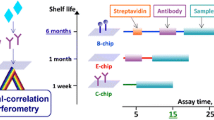Abstract
New approaches in the field of fluoroimmunoassays involve the use of optical fibres as solid support of reagents and waveguide. Parameters which influence the response of optical fibre fluoroimmunosensors have been studied. Several methods, involving either a physical or a covalent process, have been investigated for immobilizing on silica surfaces polyclonal rabbit immunoglobulin (IgG) as antigen. Fluorescent anti-rabbit IgG has been used for determining immobilized antigen levels. The fluorescence intensity emitted by the immunosensors has been determined by using the evanescent wave phenomenon. The binding capacity of the different immunosensors tested appears nearly similar, except for the sensor prepared with the 3-glycidoxypropyl trimethoxysilane coupling method which seems to exhibit a lower binding capacity. For all sensors prepared with a covalent coupling method, a simultaneous adsorption phenomenon probably affects the long-term stability of immunosensors. In a further step, the possibility of immunosensor regeneration after a dissociation of antigen/antibody complexes has been tested. It appears that the dissociation methods could affect the sensor response. Finally, the specificity of immunosensors has been investigated. A significant cross reactivity was observed forp-toluenesulphonyl chloride and 3-aminopropyl triethoxysilane (APTES)-derivatized fibres. For the APTES-derivatized sensor, the specificity markedly decreased after a dissociation step. Therefore, although the feasibility of a competitive assay has been established, suitable conditions of immunosensor regeneration still require further investigation.
Similar content being viewed by others
References
A. ZHIRI, Biofutur, in “Supplement: Le Technoscope”6 (1986) 3.
B. J. GOULD and V. MARKS, in “Nonisotopic Immunoassay”, edited by T. T. Ngo (Plenum Press, New York, London, 1988) p. 3.
J. P. GOSLING,Clin. Chem. 36 (1990) 1408.
W. R. SEITZ,J. Clin. Lab. Anal. 1 (1987) 313.
W. R. SEITZ,Anal. Chem. 56 (1984) 16.
R. E. DESSY, ibid.61 (1989) 1079.
G. BOISDE and J.-J. PEREZ,C.R.A.S., Série Générale 5 (1989) 303.
B. J. TROMBERG, M. J. SEPANIAK, T. VO-DINH and G. D. GRIFFIN,Anal. Chem. 59 (1987) 1226.
J. T. IVES, J. N. LIN and J. D. ANDRADE,Amer. Biotech. Lab. 3 (1989) 10.
M. S. ABDEL-LATIF, A. SULEIMAN, G. G. GUILBAULT, B. B. A. DREMEL and R. D. SCHMID,Anal. Lett. 23 (1990) 375.
J. D. ANDRADE, R. A. VANWAGENEN, D. E. GREGONIS, K. NEWBY and J.-N. LIN,IEEE Trans. Electron Devices 32 (1985) 1175.
K. R. ROGERS, J. J. VALDES and M. E. ELDEFRAWI,Anal. Biochem. 182 (1989) 353.
K. PACHMANN and W. LEIBOLD,J. Immunol. Methods 12 (1976) 81.
M. L. WILLIAMSON, D. H. ATHA, D. J. REEDER and P. V. SUNDARAM,Anal. Lett. 22 (1989) 803.
J. N. LIN, J. D. ANDRADE and I.-N. CHANG,J. Immunol. Methods 125 (1989) 67.
F. V. BRIGHT, T. A. BETTS and K. S. LITWILER,Anal. Chem. 62 (1990) 1065.
G. C. BLANCHARD, C. G. TAYLOR, B. R. BUSEY and M. L. WILLIAMSON,J. Immunol. Methods 130 (1990) 263.
J. L. BOITIEUX, M.-P. BIRON, G. DESMET and D. THOMAS,Clin. Chem. 6 (1989) 1026.
L. LOCASCIO-BROWN, A. L. PLANT, V. HORVATH and R. A. DURST,Anal. Chem. 62 (1990) 2587.
J. N. LIN, J. HERRON, J. D. ANDRADE and M. BRIZGYS,IEEE Trans. Biomed. Eng. 35 (1988) 466.
Author information
Authors and Affiliations
Rights and permissions
About this article
Cite this article
Claudon, P., Donner, M. & Stoltz, J.F. Potential interest of optical fibres as immunosensors: study of different antigen coupling methods. J Mater Sci: Mater Med 2, 197–201 (1991). https://doi.org/10.1007/BF00703369
Received:
Accepted:
Issue Date:
DOI: https://doi.org/10.1007/BF00703369




